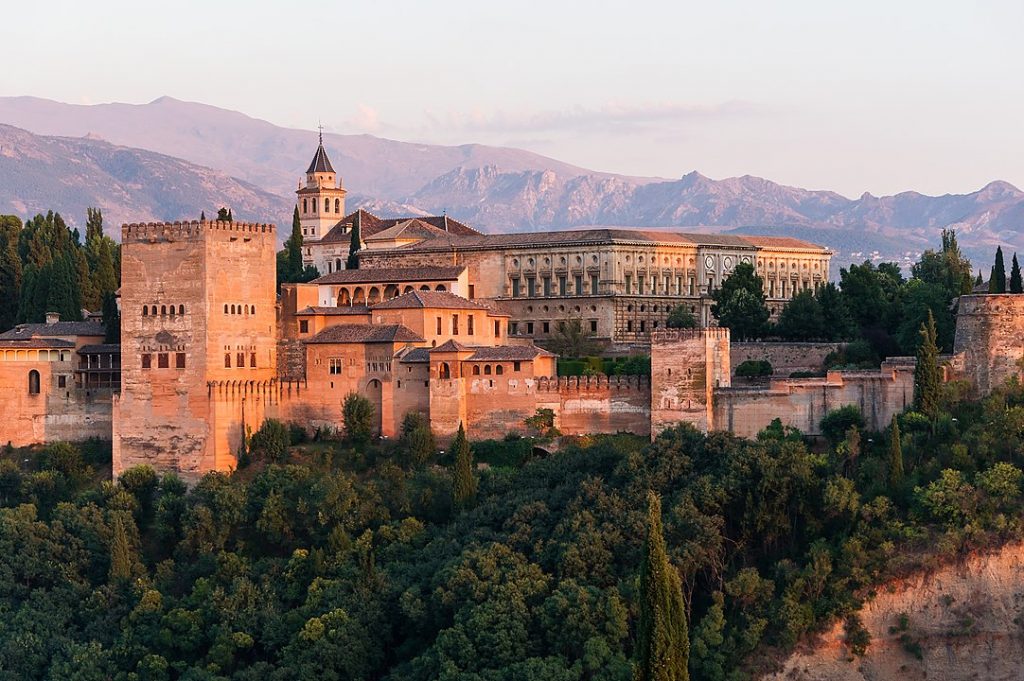
The Alhambra of Granada isn’t just a palace; it’s a sensory journey into Spain’s Moorish past. Imagine strolling through intricately carved archways, with sunlight filtering through lattice windows, casting honeycomb shadows across the floor. The scent of orange blossoms lingers in the air, while fountains murmur secrets of centuries past. Nestled against the rugged backdrop of the Sierra Nevada mountains, this architectural marvel is one of Andalusia’s most captivating landmarks and a UNESCO World Heritage Site in Granada.
Known for its fusion of Islamic art, lush gardens, and historic significance, the Alhambra attracts millions of visitors each year. It’s a place where you can almost feel the whispers of the Nasrid sultans and sense the power of the Catholic Monarchs who claimed it in 1492. What makes it truly special, though, is its ability to evoke a deep sense of wonder. American writer Washington Irving once called it “an enchanted palace,” and he wasn’t exaggerating.
The History of The Alhambra
The Alhambra’s story begins in 889 AD, originally built as a modest fortress on Roman ruins. By the 13th century, however, the Nasrid Dynasty, led by Muhammad I, transformed it into a sprawling palace complex, making it the last stronghold of Moorish Spain. Its name comes from the Arabic “al-Qal’a al-Hamra,” meaning “The Red Castle,” due to its distinctive reddish walls.
What stands out about the Alhambra is not just its historical significance but its aesthetic appeal. An early chronicler, Ibn al-Khatib, described it as “a pearl set among emeralds,” referring to its position atop a verdant hill overlooking Granada. The surrounding cypress and myrtle trees only enhance its sense of serenity.
The Nasrid Palaces in Alhambra are the heart of this grand complex. Constructed primarily during the 14th century, they consist of multiple interconnected spaces, each adorned with intricate stucco work, Arabic inscriptions, and stunning tile mosaics. The most famous of these is the Court of the Lions, a majestic courtyard surrounded by 124 slender columns and featuring a fountain guarded by twelve marble lions—a symbol of power and strength.
The Hall of the Ambassadors is another must-see, with its towering dome adorned in muqarnas, or honeycomb vaulting, a classic feature of Moorish architecture in Spain. Historian Desmond Stewart once remarked that “no other palace in Europe is as richly ornamented as the Alhambra,” emphasizing its visual opulence.
In 1492, the Catholic Monarchs Ferdinand and Isabella entered the Alhambra, marking the end of Moorish rule in Spain. The palace underwent further changes under Charles V, who added a Renaissance-style palace that stands in contrast to the Nasrid elegance. This duality in architectural styles—Islamic and Renaissance—reflects the historical shifts that the Alhambra has witnessed.
Despite these changes, the essence of the original design remains, making the Alhambra not just a symbol of the history of the Alhambra, but a testament to cultural coexistence. The French writer Théophile Gautier, after visiting in 1840, wrote: “The Alhambra has that air of immortality that belongs to the masterpieces of human genius.
Exploring Moorish Architecture in Spain
Moorish architecture is a unique blend of intricate designs, natural elements, and symbolic art—nowhere is this more evident than in the Alhambra. It’s defined by geometric patterns, stucco work, arches, and elaborate calligraphy, each detail intended to reflect the beauty of creation itself. The Alhambra’s aesthetic intricacies, like the muqarnas vaulting and Arabic poetry on the walls, make it a quintessential example of Islamic art and architecture in Spain.
Travel writer Gerald Brenan once described Moorish architecture as “a dream built in plaster and stone,” perfectly summarizing the feeling one gets when wandering through the palace’s stunning halls.
Several features characterize the Alhambra’s architecture:
- Geometric Patterns: Symmetrical designs and motifs dominate the walls, floors, and ceilings, representing order in the universe.
- Water Features: Fountains, pools, and flowing channels are integrated into courtyards, symbolizing life and purity in Islamic culture.
- Calligraphy: Arabic inscriptions, including Quranic verses and poems, cover walls and archways, making the palace not just a visual experience but a literary one.
This delicate blend of art, nature, and spirituality makes the Alhambra a masterpiece of Moorish architecture in Spain. It’s no wonder that the poet Federico García Lorca called the Alhambra “a soul carved in stone,” a testament to its timeless beauty and cultural importance.
Generalife Gardens: Alhambra’s Green Paradise
Adjacent to the Alhambra lies the Generalife, a serene summer palace surrounded by lush gardens that once served as a retreat for the Nasrid rulers. Built in the early 14th century, the Generalife embodies the ideal of paradise described in Islamic tradition—an enclosed garden with flowing water and abundant greenery.
The gardens themselves are a feast for the senses, with vibrant flower beds, towering cypress trees, and cool, shaded walkways. Water channels run alongside paths, leading to picturesque fountains that symbolize purity and abundance. It’s no surprise that the Generalife gardens are considered among the finest Andalusia landmarks. As writer Edith Wharton put it, “The Generalife’s gardens seem to stretch like a dream over the hillside.”
The Generalife was designed for leisure, a stark contrast to the more formal Nasrid Palaces. The summer palace includes simple yet elegant rooms overlooking the Sierra Nevada mountains backdrop, offering a sense of tranquility that the Nasrid sultans treasured. Architectural features here are simpler than in the main palace but still reflect the beauty of Islamic art and architecture—from whitewashed walls to intricate wooden ceilings and patterned tiles.
Visiting the Alhambra Palace: What You Need to Know
To fully appreciate the Alhambra’s beauty, timing is key. Spring (March to May) and autumn (September to November) are the best seasons for visiting, offering pleasant weather and fewer crowds. Early mornings or late afternoons provide softer lighting, casting a golden glow over the complex’s reddish walls and lush gardens, creating a magical ambiance.
Due to its popularity, getting tickets to the Alhambra can be challenging without some planning. It’s best to book tickets online weeks in advance to secure your preferred time slot. There are several ticket options, including general admission, night visits, and combined tickets that allow access to other Granada tourist attractions.
The Alhambra is full of must-see highlights: the Court of the Myrtles, the Hall of the Two Sisters, and the Alcazaba fortress, which offers panoramic views of Granada and the Sierra Nevada mountains backdrop.
The Symbolism of The Alhambra
The Alhambra represents the peak of Islamic civilization in Spain, showcasing elements of Arabic poetry, geometric patterns, and Quranic inscriptions that merge art, science, and spirituality. It embodies concepts of paradise, spirituality, and power, with water as a recurring element, symbolizing both purification and life.
Spanish poet Federico García Lorca captured the Alhambra’s mystique perfectly: “Granada is in the eyes of the Alhambra.” His words reflect how the palace has influenced the city’s soul, art, and spirit.
The Alhambra has been a source of inspiration for writers, artists, and musicians throughout the centuries. Washington Irving, the American author of “Tales of the Alhambra,” brought global attention to the palace through his romantic tales of Moorish legends and mystical adventures.
Alhambra and UNESCO World Heritage Status
The Alhambra was designated as a UNESCO World Heritage Site in Granada in 1984, recognized for its historical, cultural, and architectural significance. The site’s global fame has helped local businesses thrive, contributing to the economy while maintaining the city’s historical integrity. Authorities have implemented measures like limited daily visitor numbers to minimize wear and tear on the site.
Just beyond the Alhambra’s gates lie the historic neighborhoods of the Albaicín and Sacromonte, known for their Moorish charm and vibrant flamenco culture. The Alhambra’s strategic position on the Sabika Hill also provides breathtaking views of the Sierra Nevada mountains backdrop, adding a touch of natural majesty to its grandeur.
Final Thoughts
The Alhambra is more than a historic site; it’s an enduring masterpiece that captures the essence of Spain’s rich cultural mosaic. It’s a place that invites exploration, contemplation, and, above all, admiration. As Washington Irving aptly noted: “How unworthy is my scribbling of the place!”—a sentiment many travelers share, as words can only capture so much of its timeless beauty.
Key Takeaways
- The Alhambra of Granada is not only a stunning example of Moorish architecture in Spain but also a symbol of cultural harmony and historical transformation.
- The Nasrid Palaces in Alhambra showcase intricate Islamic art, featuring geometric designs, calligraphy, and symbolic water features, which continue to enchant visitors today.
- The Generalife gardens offer a serene escape, filled with vibrant flora, cooling water channels, and panoramic views of the Sierra Nevada mountains backdrop.
- Visiting the Alhambra Palace requires thoughtful planning, especially during peak seasons, but it’s well worth the effort for its unmatched beauty and history.
- As a UNESCO World Heritage Site in Granada, the Alhambra continues to captivate travelers from around the world, standing as a testament to Spain’s diverse past.
FAQs
- What makes the Alhambra of Granada unique?
- It combines Islamic and Renaissance architectural styles, surrounded by lush gardens and stunning views of the Sierra Nevada mountains.
- How long does it take to visit the Alhambra?
- A typical visit lasts about 3-4 hours, allowing enough time to explore the Nasrid Palaces, Alcazaba, and Generalife gardens.
- Can I buy Alhambra tickets on the same day?
- Same-day tickets are rare due to high demand. It’s best to book online in advance to ensure entry.
- Why is the Alhambra a UNESCO World Heritage Site?
- It’s recognized for its historical, architectural, and cultural significance, reflecting the height of Moorish civilization in Spain.
- What are the main highlights of the Alhambra?
- Key highlights include the Court of the Lions, the Hall of the Ambassadors, and the serene Generalife gardens.




